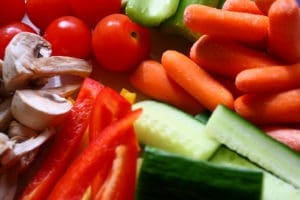By Melanie Stewart
 Last month, it was about encouraging healthy eating for children. One of the most common complaints is an aversion to vegetables. Given that this food group is indisputably important, the first recommendation is to introduce vegetables early and often. Even if the baby seems to react negatively, consistency is key. If kids are a little older, the advice still stands: Modeling and consistency. And, of course, one can get a little creative with cooking methods and recipes.
Last month, it was about encouraging healthy eating for children. One of the most common complaints is an aversion to vegetables. Given that this food group is indisputably important, the first recommendation is to introduce vegetables early and often. Even if the baby seems to react negatively, consistency is key. If kids are a little older, the advice still stands: Modeling and consistency. And, of course, one can get a little creative with cooking methods and recipes.
The first and easiest cooking technique is to simply wash, chop and eat. Fresh raw vegetables are LIVE foods that are enzyme active and alkalizing to the systems. As a rule, a minimum of 50% of your daily food intake should be healthy, fresh, LIVE foods. Including fresh raw vegetables will not only help reach that goal, it will also help with acid/alkaline balance and fiber needs – all the while providing an amazing array of nutrients. To encourage children, set out cut veggies at a time you know they are truly hungry. Everything tastes better when hungry! Allowing them to dip veggies in salad dressing or even peanut butter might also encourage them to indulge.
 Although most vegetables can be eaten raw, there are some that require cooking to neutralize certain elements. For example, eggplant and potatoes contain a compound called solanine, which inhibits the absorption of calcium and can cause neurological and gastrointestinal disorders. Some green beans, lima beans, and kidney beans require cooking to neutralize compounds that cannot only block the absorption of important nutrients, they can be toxic enough to make you ill. Most greens and cruciferous vegetables can be eaten raw however; some cruciferous vegetables contain goitrogenic substances that can block the production of the thyroid hormone. If one has a disorder of the thyroid, it may be beneficial to cook these vegetables more often than not.
Although most vegetables can be eaten raw, there are some that require cooking to neutralize certain elements. For example, eggplant and potatoes contain a compound called solanine, which inhibits the absorption of calcium and can cause neurological and gastrointestinal disorders. Some green beans, lima beans, and kidney beans require cooking to neutralize compounds that cannot only block the absorption of important nutrients, they can be toxic enough to make you ill. Most greens and cruciferous vegetables can be eaten raw however; some cruciferous vegetables contain goitrogenic substances that can block the production of the thyroid hormone. If one has a disorder of the thyroid, it may be beneficial to cook these vegetables more often than not.
A common misconception is that cooking will destroy vital minerals and vitamins but this is not the case when done properly. In fact, for some vegetables heating can increase digestibility by breaking down the cellulose wall, providing easier access to the nutrients while destroying or neutralizing the anti-nutrients. Heat based cooking techniques including roasting, stir-frying, or grilling should be done quickly when using high temperatures to preserve nutrient content and prevent the formation of acrylamide, which is potentially carcinogenic. Most vegetables are best served al dente, rather than cooked soft, highlighting the flavor and enhancing the nutrient content.
NOTE: Microwave cooking creates irradiated foods that have molecules found NOWHERE in nature. I do NOT recommend cooking vegetables in the microwave, especially NOT in any type of plastic bag or container.
One favorite way to prepare vegetables is super easy and sure to please even the most finicky palate. ROASTED (BAKED): Simply cut vegetables so that they are a similar size, toss in oil, put on a cookie sheet or place in a shallow roasting pan and season. Slow roasting at 325 degrees will dehydrate vegetables while sweetening their flavor. This method is good for root vegetables like potatoes and beets. Medium temperature baking at 350 degrees will cook the vegetables evenly and round out their flavors, while high temperature baking at 400 degrees or higher will caramelize the vegetables but leave them juicy and al dente. Simple seasoning with sea salt and ground pepper works well for almost every vegetable, highlighting their natural and unique flavors.
The cruciferous vegetables like broccoli, asparagus, brussel sprouts and cauliflower are particularly good roasted. If one has never been a fan of these vegetables before, try them this way seasoned with nothing more than salt and pepper. Root vegetables like potatoes, onions, carrots, beets and garlic are also terrific roasted. Simply toss in oil and season with salt and pepper. Fifteen minutes before they are ready add some fresh chopped rosemary to really give good flavor.





























































